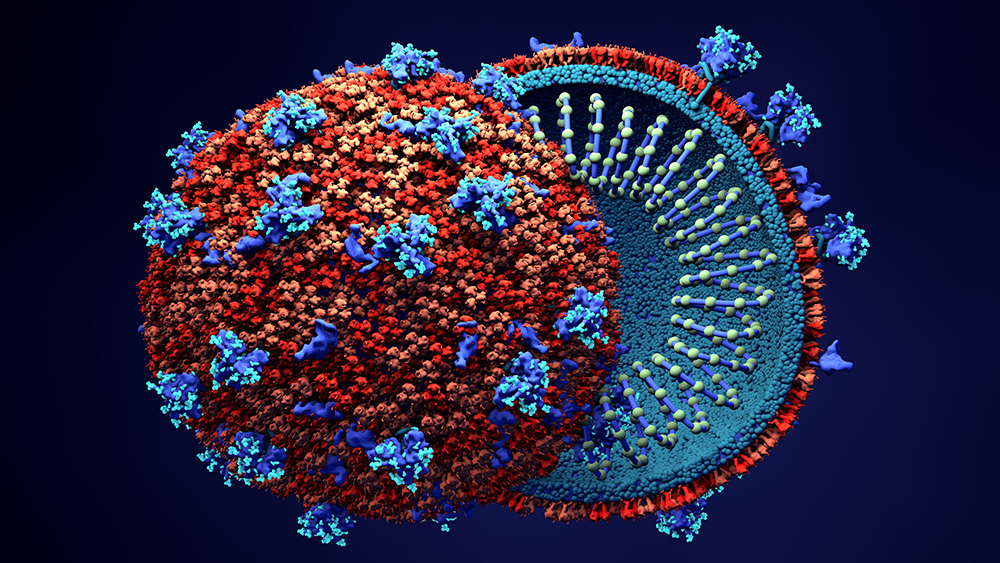Scientists warn about new “mutant” strain of the coronavirus that’s MORE infectious
05/07/2020 / By Ethan Huff

A new strain of novel coronavirus has been identified that scientists claim may be more contagious than the one that predominantly spread during the early days of the pandemic.
A new study by researchers at the Los Alamos National Laboratory contends that this new strain of the Wuhan coronavirus (COVID-19) first appeared in Europe back in February. Since then, it has reportedly spread to the East Coast of the United States and become the dominant strain throughout most of the world.
This new strain is said to spread faster than the original, and can also make people more vulnerable to developing a second infection. It also has altered “spikes” on its exterior that affect the way it enters human respiratory cells.
The 33-page report, which appears in the journal BioRxiv, is not yet peer-reviewed. However, it is being circulated in an effort to speed up collaborations with scientists who are working on developing vaccines for the Wuhan coronavirus (COVID-19).
News reports note, however, that a vaccine for the original strain may not also work for this mutated strain, which could render all vaccine development efforts as futile.
Up until now, those pushing for the development of a new vaccine for the Wuhan coronavirus (COVID-19) have simply assumed that it would not mutate in the same way as seasonal influenza viruses, which require new vaccines every year. But this new study, if verified, will dash that assumption.
If validated, this paper proves that there is no way to create an effective vaccine against coronavirus
This study is based on a computational analysis of more than 6,000 different coronavirus sequences that were collected from all around the world by the Global Initiative for Sharing All Influenza Data, a public-private non-profit organization based out of Germany.
What this analysis ultimately revealed is that the new mutated strain of the Wuhan coronavirus (COVID-19) is constantly transitioning to become the dominant one, putting all, or at least many, of the earlier strains out of commission.
All in all, the Los Alamos team, with help from researchers from several other major universities, identified 14 different mutations of the Wuhan coronavirus (COVID-19) in circulation. These mutations occurred among the nearly 30,000 base pairs of RNA that comprise the genome of the coronavirus.
“The story is worrying, as we see a mutated form of the virus very rapidly emerging, and over the month of March becoming the dominant pandemic form,” stated study leader Bette Korber, a computational biologist at Los Alamos, in a Facebook post.
“When viruses with this mutation enter a population, they rapidly begin to take over the local epidemic, thus they are more transmissible.”
Scientists reacting to the study say that it certainly provides some interesting insights into the nature of this beast. Teams aiming to develop a vaccine for the Wuhan coronavirus (COVID-19) need to be “watching papers like this very carefully,” one scientist stated.
It is important to note that while this mutated coronavirus strain might be more contagious, it is not necessarily more lethal. In fact, it could end up being milder or not even noticeable compared to other strains. The paper merely suggests that it “replicates better” than other strains.
“There is a lot of speculation here,” commented Dr. Peter Hotez, co-director of Texas Children’s Hospital Center for Vaccine Development, which has a vested interest in producing new vaccines. “They have no experimental verification.Scientists warn about new “mutant” strain of coronavirusScientists warn about new “mutant” strain of coronavirus.
More of the latest news about the Wuhan coronavirus (COVID-19) is available at Pandemic.news.
Sources for this article include:
Tagged Under: China, Chinese Virus, contagious, coronavirus, covid-19, disease, global emergency, Global Pandemic, infection, infections, mutant strain, mutations, novel coronavirus, outbreak, pandemic, virus, Wuhan, Wuhan coronavirus



















